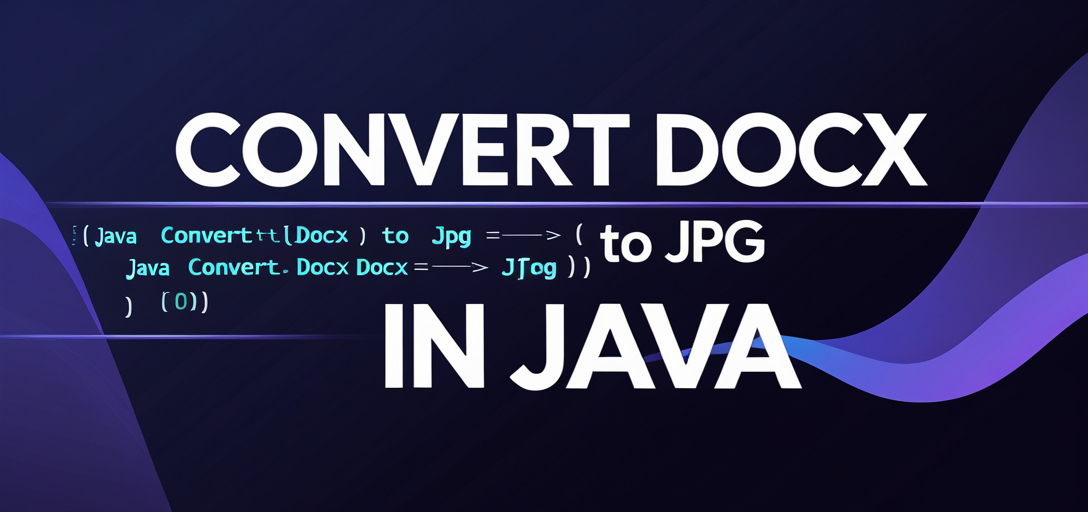Master Rendering DOCX to JPG in Java with GroupDocs.Viewer
Introduction
In today’s digital landscape, converting documents into images is essential for web sharing or application embedding. This tutorial demonstrates how to convert a Word document (DOCX) into high-quality JPEG images using GroupDocs.Viewer in Java, allowing control over image quality and file size.

By following this guide, you’ll learn:
- Setting up GroupDocs.Viewer for Java
- Rendering DOCX files to JPG with adjustable quality settings
- Optimizing performance during document processing
Let’s begin by reviewing the prerequisites!
Prerequisites
Before starting, ensure you have the necessary tools and knowledge in place.
Required Libraries and Dependencies
Include the GroupDocs.Viewer library for Java using Maven:
Maven Setup
<repositories>
<repository>
<id>repository.groupdocs.com</id>
<name>GroupDocs Repository</name>
<url>https://releases.groupdocs.com/viewer/java/</url>
</repository>
</repositories>
<dependencies>
<dependency>
<groupId>com.groupdocs</groupId>
<artifactId>groupdocs-viewer</artifactId>
<version>25.2</version>
</dependency>
</dependencies>
Environment Setup
- Ensure you have the Java Development Kit (JDK) installed.
- Use an IDE like IntelliJ IDEA or Eclipse for writing and running your code.
Knowledge Prerequisites
Familiarity with basic Java programming concepts, such as classes, methods, and file I/O operations, is helpful. Experience with Maven is advantageous but not mandatory.
Setting Up GroupDocs.Viewer for Java
Installation Information
Maven Setup
Add the following configuration to your pom.xml file:
<repositories>
<repository>
<id>repository.groupdocs.com</id>
<name>GroupDocs Repository</name>
<url>https://releases.groupdocs.com/viewer/java/</url>
</repository>
</repositories>
<dependencies>
<dependency>
<groupId>com.groupdocs</groupId>
<artifactId>groupdocs-viewer</artifactId>
<version>25.2</version>
</dependency>
</dependencies>
License Acquisition
GroupDocs offers a free trial, a temporary license for extensive testing, and purchasing options for full functionality:
- Free Trial: Explore basic features with the trial version.
- Temporary License: Acquire this for comprehensive access during development.
- Purchase: Choose between a subscription or one-time purchase based on your needs.
Basic Initialization
Initialize GroupDocs.Viewer in Java by creating an instance of the Viewer class:
try (Viewer viewer = new Viewer("path/to/document.docx")) {
// Use this viewer object to render documents.
}
Implementation Guide
Now that we’ve set up GroupDocs.Viewer for Java, let’s implement our feature: rendering a DOCX file as a JPG image with adjustable quality.
Rendering Document to JPG with Quality Adjustment
Overview
This section guides you through adjusting the output JPG quality when converting documents. This control allows balancing between image clarity and file size based on your needs.
Step 1: Configure Output Directory Define where your output images will be saved:
Path outputDirectory = Paths.get("YOUR_OUTPUT_DIRECTORY", "AdjustQualityWhenRenderingToJpg");
Step 2: Set Up File Path Format Specify the format for naming output files:
Path pageFilePathFormat = outputDirectory.resolve("page_{0}.jpg");
Step 3: Initialize JpgViewOptions Set up rendering options, including file path and quality settings:
JpgViewOptions viewOptions = new JpgViewOptions(pageFilePathFormat);
Step 4: Adjust Image Quality Set the desired image quality (1-100):
byte quality = 50; // Adjust based on your needs.
viewOptions.setQuality(quality);
Step 5: Render Document to JPG Load your document and render it using the configured options:
try (Viewer viewer = new Viewer("YOUR_DOCUMENT_DIRECTORY/SAMPLE_DOCX")) {
viewer.view(viewOptions);
}
Troubleshooting Tips
- Common Issue: File path errors. Ensure all paths are correctly specified and accessible.
- Performance Tip: For large documents, consider rendering in batches to manage memory usage effectively.
Practical Applications
This feature has numerous real-world applications:
- Document Sharing Platforms: Render high-quality previews for quick sharing.
- Content Management Systems: Convert articles or reports into images for easier embedding.
- Archiving Solutions: Create image archives of documents with adjustable quality settings to save storage space.
Performance Considerations
To ensure optimal performance when rendering documents:
- Optimize Memory Usage: Use
try-with-resourcesto manage resources efficiently. - Batch Processing: For large batches, process in chunks to prevent memory overflow.
- Quality Settings: Lower the quality for faster rendering if high clarity isn’t required.
Conclusion
Congratulations! You’ve mastered converting DOCX files into JPG images with adjustable quality using GroupDocs.Viewer for Java. This skill can enhance document handling and sharing capabilities across various applications.
For further exploration, consider experimenting with different file types supported by GroupDocs.Viewer or integrating this functionality within larger projects.
FAQ Section
- What is the range of quality settings in GroupDocs.Viewer?
- Quality ranges from 1 (lowest) to 100 (highest).
- Can I render PDF files using GroupDocs.Viewer Java?
- Yes, GroupDocs.Viewer supports rendering PDFs and many other formats.
- How do I handle large documents efficiently?
- Consider batch processing and optimizing memory usage.
- Is a license required for all features in GroupDocs.Viewer?
- A free trial allows access to basic features; more advanced features require a license.
- What are some best practices for integrating GroupDocs.Viewer Java into existing systems?
- Ensure proper dependency management, test with various file formats, and optimize rendering settings based on use cases.
Resources
- Documentation
- API Reference
- Download GroupDocs.Viewer for Java
- Purchase License
- Free Trial Version
- Temporary License
- Support Forum
Now that you’ve understood the process, start implementing these features in your projects!